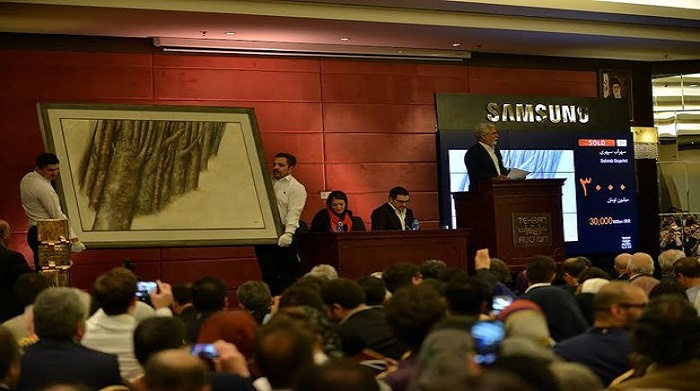Tehran Auction Continues To Break Records

The auction of modern and contemporary Iranian art is an annual event jockeying to be among the big auctions in the Middle East in recent years. On Friday night, Azadi Hotel was host to the 5th edition of the Tehran Auction where the best of Iranian art, ranging from established and emerging artists, were presented to art collectors and a global audience.
The auctioneer, Hossein Pakdel, a well-known Iranian actor, screenwriter and director, hosted among others a number of Iranian culture officials and celebrities, including Culture Minister Ali Jannati, famed soccer personality Ali Daei and composer Shahrdad Rohani.
The first winning bidder was Elnaz Shakerdoust, a popular star of Iran’s mainstream cinema, who bought a work by Nasser Oveissi for 950 million rials.
An untitled tree trunk painting by celebrated Iranian poet and painter Sohrab Sepehri, a regular in overseas auctions, sold for 30 billion rials (a little short of a million dollars), becoming the most expensive painting ever sold in Iran, just as another piece from the same collection did last year. That amounted to a fifth of the whole sales. Still another oil on canvas by Sepehri was bought for 15.5 billion rials.
Other notable works auctioned were Bahman Mohasses’ oil on canvas “Still Life”, at 8.5 billion rials, and “Sublimation”, a miniature by Mahmoud Farshchian, which was sold for 10.25 billion rials.
The auction offered almost eighty works of art, among them 14 classics from painters including the legendary Kamal-ol-molk. Only one work went unsold and two works were hammered below their low estimates. The “Remaining Objects” became the cheapest sold for 300 million rials.
The total proceeds of Tehran Auction 2016 stood at $8,328,880 which broke the record of last year’s $6,909,536, according to Mehr News Agency. The first of its kind in Iran, Tehran Auction was launched in 2012 as an independent and private initiative to support the domestic art market as a key basis for the international market. Before that, the record for the most expensive Iranian artwork was set by Tanavoli’s sculpture Oh Persepolis, which sold for $2.8m (£1.8m) at Christie’s Dubai in 2008.
The auction has seen mixed receptions among visual arts observers. There have been debates about the authenticity of the works, the pricing methodology, and the emergence of a philistine nouveau riche class that are readily spending thousands of dollars to hang a work of art in their luxury houses. Underground dealership, money laundering, and nominal sales are among other allegations. Others find the auction a platform to attract attention and inject money into the arts, paving the way for emerging artists to get in touch with real audiences, curators and collectors.
Some also argue that the attitude of Iranian politicians towards art has been changing. At the moment, Tehran’s City Hall has replaced billboard ads in the city with art pieces by local and international artists, including Picasso and Magritte, for a period of 10 days. The project dubbed “A gallery as big as a city” was first launched last year and is now being re-implemented following positive vibes from the public.

